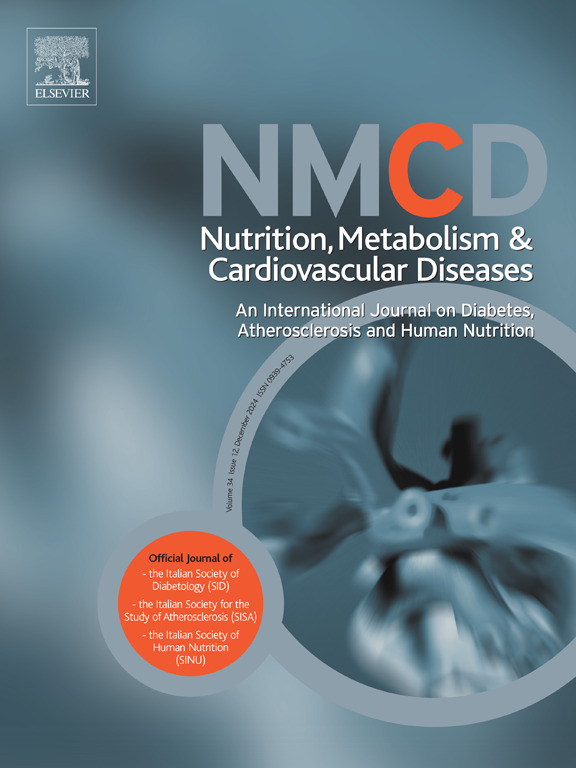MAFLD/MASLD和亚型与心血管疾病结果的比较关联。
IF 3.3
3区 医学
Q2 CARDIAC & CARDIOVASCULAR SYSTEMS
Nutrition Metabolism and Cardiovascular Diseases
Pub Date : 2025-03-19
DOI:10.1016/j.numecd.2025.104024
引用次数: 0
摘要
背景和目的:代谢功能障碍相关脂肪性肝病(MASLD)可作为区分代谢功能障碍相关脂肪性肝病(MAFLD)的替代方法。本研究旨在探讨影响MAFLD和MASLD与主要心血管结局发生率关系的因素。方法和结果:英国生物银行研究共纳入340,998名参与者。采用多变量Cox比例风险模型,以风险比(hr)和95%置信区间(ci)估计MAFLD和MASLD对心血管疾病(冠心病、中风、心力衰竭和心血管疾病相关死亡)结局的影响。共有126,077名(36.97%)参与者患有MAFLD, 97,418名(28.57%)参与者患有MASLD。在中位随访13.5年(四分位数间距12.6-14.2)期间,记录了41,548例cvd新病例。mld (hr = 1.52;95% CI: 1.49-1.55)和MASLD (HR = 1.42;95% CI: 1.39-1.45)与心血管疾病的高风险相关。在MAFLD和脂肪变性肝病(SLD)亚型中,MAFLD糖尿病亚型(HR = 2.26;95% CI: 2.17-2.35)和酒精相关性肝病(ALD) (HR = 1.65;95% CI: 1.55-1.76)表现出心血管疾病的最高风险。无MD亚型的MAFLD超重与cvd无相关性。无论是否存在MASLD, mald对CVD结果的影响是一致的。结论:与肥胖相比,代谢健康状况和酒精消耗是评估MAFLD或MASLD患者心血管疾病结局的更关键因素。本文章由计算机程序翻译,如有差异,请以英文原文为准。
Comparative association of MAFLD/MASLD and Subtypes with Cardiovascular Diseases Outcomes
Background and aims
Metabolic dysfunction-associated steatotic liver disease (MASLD) acts as an alternative for demarcating metabolic dysfunction-associated fatty liver disease (MAFLD). This study aimed to investigate the factors that significantly influence the relationship between MAFLD and MASLD in relation to the incidence of major cardiovascular outcomes.
Methods and results
A total of 340,998 participants in the UK Biobank study were included. Multivariable Cox proportional hazards models were used to estimate the effect of MAFLD and MASLD on the outcomes of cardiovascular diseases (CVDs) (coronary artery disease, stroke, heart failure, and CVD-related death) with hazard ratios (HRs) and 95 % confidence intervals (CIs). A total of 126,077 (36.97 %) participants had MAFLD and 97,418 (28.57 %) had MASLD. Over a median follow-up of 13.5 years (interquartile range 12.6–14.2), there were 41,548 new events of CVDs recorded. MAFLD (HR = 1.52; 95 % CI: 1.49–1.55) and MASLD (HR = 1.42; 95 % CI: 1.39–1.45) were associated with high risks of CVDs. Among the subtypes of MAFLD and steatotic liver disease (SLD), MAFLD diabetes subtype (HR = 2.26; 95 % CI: 2.17–2.35) and alcohol-associated liver disease (ALD) (HR = 1.65; 95 % CI: 1.55–1.76) exhibited the highest risk of CVDs. MAFLD overweight without MD subtype were not associated with CVDs. The effect of MAFLD on the CVD outcomes was consistent regardless of the presence of MASLD.
Conclusion
The metabolic health status and alcohol consumption function as more critical factors than obesity in assessing CVD outcomes in participants with MAFLD or MASLD.
求助全文
通过发布文献求助,成功后即可免费获取论文全文。
去求助
来源期刊
CiteScore
6.80
自引率
2.60%
发文量
332
审稿时长
57 days
期刊介绍:
Nutrition, Metabolism & Cardiovascular Diseases is a forum designed to focus on the powerful interplay between nutritional and metabolic alterations, and cardiovascular disorders. It aims to be a highly qualified tool to help refine strategies against the nutrition-related epidemics of metabolic and cardiovascular diseases. By presenting original clinical and experimental findings, it introduces readers and authors into a rapidly developing area of clinical and preventive medicine, including also vascular biology. Of particular concern are the origins, the mechanisms and the means to prevent and control diabetes, atherosclerosis, hypertension, and other nutrition-related diseases.

 求助内容:
求助内容: 应助结果提醒方式:
应助结果提醒方式:


